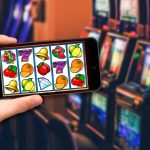Today, slots account for the vast majority of the action that takes place at a casino. Both online and in the real world, casinos collect most of their revenues from slots. Precisely why have they are available in no short supply, and are constantly being reinvented to bring new players on board.
Large resorts in Las Vegas, Atlantic City and Macau are lined with hundreds or even thousands of these machines, and there are never many left unused for long. Online, it’s not uncommon for even the most modest virtual casino to have an arsenal of thousands of slots on offer 24/7.
In the UK, where they’re technically known as “fixed-odds betting terminals”, these games have proved popular for generations. There are even plenty of establishments where slots are the only games on offer, due to their enormous popularity.
Online, the sheer range of different video slot games is astonishing to say the least, with a whole host of popular themes including zombies, Vikings, Ancient Egypt, movies, space, and even the ocean.
But with the impressive technology that’s become the norm in today’s slots, it can be easy to forget about the history of the slot machine. Specifically, how it went from being one man’s somewhat rudimentary invention to become a hugely popular pastime in a little over a century.
The Early Days
A German immigrant to the United States, Charles August Fey is widely credited with inventing the slot machine. Up to that point, he’d had a varied career, working in a farming tool factory, before moving to California where he became an electrical engineer.
Fey created his first slot machine in 1895. This wasn’t actually the first machine of its kind as it was a modified version of the “Horseshoes Slot Machine” that had been created two years earlier by Gustav Friedrich Willhelm Shultze, however, it was Fey’s machine that first included the option to pay out coins as the prize.
In 1898, Fey created the “Liberty Bell Slot Machine”, named after the three bells which, when aligned on the front of the machine, paid out the jackpot of 50 cents.
Copycats
For reasons that are still not completely clear, Fey decided not to patent his Liberty Bell. This meant many copycat machines quickly began appearing around California and the rest of the United States.
Theoretically, he could have made one of the most enormous personal fortunes in the history of entrepreneurship, had he copyrighted the design of his machine and taken a cut from anyone out to build their own. But he didn’t, so the market found itself being flooded with new and innovative designs.
One of these machines was made in conjunction with a chewing gum manufacturer. Instead of paying out coins, players won sticks of flavoured gum. The machine used pictures of fruit on the reels, with players winning the corresponding flavour if they lined up three of the same.
It is for this reason that we still often see fruit used on the reels of slot machines today, and it’s also why they’re often called “fruit machines”.
Video Slots
For the best part of a century, slot machines worked in mostly the same way, using physical reels that were activated by the player pulling a lever or pushing a button. This changed in the late 1970s when the first video slots were developed.
These machines swapped the physical reels for a video screen and used computer algorithms to decide the outcome instead of physics.
The video slot has evolved a lot over the decades. Modern games include full HD graphics, exciting animations, and even full video cut-scenes. They now also contain bonus games that use different mechanics from the standard slot reels.
For example, the Top Gun Slot game contains a dogfight bonus round that recreates the famous air-to-air combat scenes in the hit movie, Top Gun (1986).
The Internet
Like almost everything else in the world, slot games were changed by the internet. They have become more accessible, allowing more people to enjoy the bright colours and fun animations by playing them through their computers, smartphones, or tablets.
This has also increased innovation in the video slot market, with developers like Microgaming introducing more licensed games that use imagery and other content from TV shows and movies. Others have introduced new elements to their slot games such as progressive and daily jackpots, multiple paylines, and symbols that span more than one position on the reel.
The slot machine has come a long way since its humble beginnings back in the late 19th century and has turned into an incredibly successful and popular type of game that’s enjoyed by millions around the world each year.
What’s Next for Slot Machines?
For the most part, the future is likely to bring more of the same for the slot machine. More sophisticated and technologically advanced slots, more exciting game play and more familiar themes to get punters interested.
In terms of major shifts, there are two things industry watchers are expecting to see more of over the coming years and decades.
One of which is the widespread use of virtual reality hardware for online casino gaming, which could translate to an incredibly immersive experience for those playing online slots. The second is an entirely new slot machine genre, combining traditional slot gaming with a skill-based element. Rather than the outcome being based purely on luck, these skill-based slots will provide players with the opportunity to boost their odds of winning by making the right moves at the right times.
Across the board, the popularity of online slots is predicted to continue growing indefinitely. Accessibility is already at an all-time high, with thousands of slots available via any mobile device at the touch of a button.
Slots have come a long way since their early origins, but what the future holds for online slots in particular could be even more exciting than anything we’ve seen to date.
You might also find the following articles interesting:
- 10 Ways to Make Money While Gambling
- 8 Things Your Casino Doesn’t Want You to Know
- 7 Things You Didn’t Know About Remote Gambling














